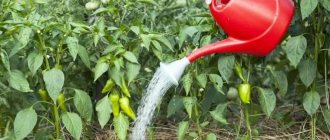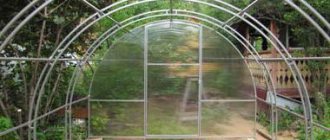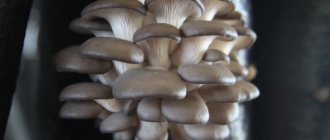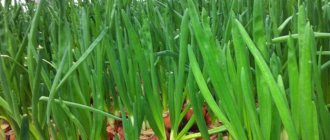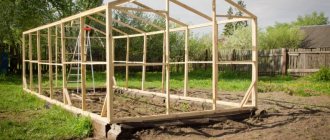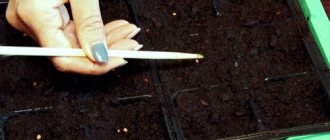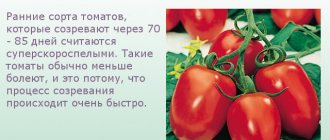In greenhouses, sweet bell peppers ripen faster and are guaranteed. You can easily grow tall bushes and get the first harvest from the earliest varieties of pepper. By choosing the best and most productive greenhouse varieties, you can get large, juicy and healthy peppers. There are also some peculiarities when growing peppers in a polycarbonate greenhouse.
The best varieties of peppers for greenhouses
Choosing the best varieties of pepper is quite difficult. Every gardener has his own “favorites”.
We suggest focusing on those varieties that produce decent yields, beautiful, tasty fruits and ripen in a short time.
We recommend the best pepper varieties for greenhouses:
- Agapovsky (1995),
- Atlant (2007),
- Bogatyr (1996)
- Chocolate Oriental Star (2006),
- Mastodon
Agapovsky |
The variety can be called the best for 3 reasons:
- the weight of the fruit reaches 120 g and on nutritious soil it can be even more,
- from germination to ripeness it can take only 98 days,
- This is a very compact plant.
The fruits are quite large for such a baby, have a bizarre prism shape and a smooth surface with barely visible ribs.
- Fully ripe peppers are scarlet in color.
- The number of nests varies from 3 to 4.
- The fruits are drooping with a wall thickness of up to 0.7 cm.
The taste is pretty good. The aroma is strong and pleasant.
| ADVICE The best way to protect tomatoes in a greenhouse from whiteflies is a hanging glue trap-screen “Mashenka”. Effective and safe, a reliable environmentally friendly way to control pests! |
Photo: effective glue trap “Mashenka” from insect pests in a greenhouse
Mastodon |
Harvest sweet pepper Mastodon, combining early ripeness with large juicy heavy fruits! Designed for cultivation in unheated and heated greenhouses.
The fruits are large, cuboidal, 3-chambered, weighing 200-270 g, measuring 12-13x9-11 cm, with a pericarp thickness of 6-7 mm, dark green in technical ripeness, red in biological ripeness.
- From germination to technical ripeness 105-125 days, to biological ripeness - 140 days.
- The bush is medium-sized, sparse, 140-180 cm high in unheated greenhouses.
- Planting density 3 plants/m².
It stands out for its stable harvest and high taste. Resistant to tobacco mosaic virus.
Order seeds directly
Photo: productive large-fruited Mastodon variety for the greenhouse
Atlant |
The variety has enough advantages to become the best.
- Fruit weight is about 190 g. The taste is excellent. The variety produces more than 3.5 kg of fruit per 1 m².
- The fruits themselves are drooping, cone-shaped and highly glossy. At biological ripeness, the fruits become bright scarlet.
- There can be from 3 to 4 nests. The wall thickness is 5.3 mm.
Peppers are good for consumption both fresh and for preparing any dishes, including hearty, tasty preparations for the winter.
Star of the East Chocolate |
The name itself seems to speak for itself. The pepper is tasty, juicy, unusual in color - a real star.
- The weight of mature dark brown peppers can reach 355 g.
- From every 1 m² you can collect more than 10 kg of fruit.
- All fruits are drooping, cylindrical in shape, with 2 or 3 nests.
- Wall thickness approx. 1 cm makes the pepper taste excellent. At the same time, the aroma is practically not felt.
The fruits are good for stuffing, pickling, in salads, stews, lecho and other dishes. For example, you can try recipes for preparing peppers for the winter.
Variety of Peppers
There are more than a thousand varieties of pepper in the world. the sweet type of pepper crops that received the most varieties
They differ from each other in terms of ripening, size and color of the fruit, fleshiness of the walls, weight and other characteristics. There are varieties specially bred for harsh climatic zones and, conversely, those that bear fruit well in warm regions. Varieties for open ground and greenhouses, pollinated and non-pollinated, labeled F1 (hybrids), are divided into separate categories.
Pepper culture as a type of spice is classified into:
- Spicy types are real crops, these include black and white peppers, Javanese, cumucus, long, and African.
- Sweet peppers are the so-called bell peppers, which are mainly grown in garden beds and greenhouses.
- Hot - varieties of red peppers, for example, chili, jalapeno, cayenne, Indian.
- False - do not belong to the Pepper plants, they include cumba and aromatic xylopia.
- Fragrant - this group combines Jamaican, Japanese and malaguetta.
Reference. A large number of varieties of sweet peppers are superior to lemon and black currant in their ascorbic acid content.
Yield varieties of peppers for greenhouses
In a greenhouse, you can create and regulate the most favorable conditions for growing peppers. Suitable temperature, humidity and light conditions, sufficient mineral and organic nutrition will allow you to obtain record and guaranteed yields.
| The most productive greenhouse pepper varieties produce more than 14 kg of fruit per 1 m² |
Among these generous varieties are:
- Atlant (2007),
- ox ear (2007),
- Gemini (2007),
- Latino (2012).
Latino |
An outstanding hybrid with a fruit weight of 240 g, and maybe more if you follow all the recommendations of agricultural technology.
- The fruit has a drooping, cube-shaped shape, red or dark red in color when biologically ripe.
- The number of nests varies from 3 to 4.
- With a fruit weight of 240 g, the wall thickness can be slightly more than 1 cm, the yield with such a mass is slightly more than 14 kg per 1 m².
The bush ripens early, is slightly spreading and not very tall, the taste of the fruit is excellent.
Jackmini |
The ripening period is mid-early, the plant itself is semi-spreading with drooping fruits, cylindrical in shape and glossy in color.
- The variety is distinguished by fruits with a maximum weight of 206 g. At the same time, it is guaranteed to produce 14.3 kg per 1 m².
- For this, the soil needs to be nutritious and fully cared for according to all the rules.
- At biological ripeness, the fruit is deep yellow.
- The number of nests can be 2 or 3, and the thickness of the fruit wall is about 0.7 cm.
The taste is excellent. Peppers exhibit all their taste perfectly both fresh and in any processing.
ox ear |
Among the productive varieties, this representative has the most modest fruit in size.
- With a pepper mass of 200 g, the yield is still at least 14 kg per 1 m².
- The variety is characterized by mid-ripening, spreading bush shape and low height.
- The fruits are drooping, shiny, and cone-shaped.
- Biologically ripe fruits are bright red.
- Wall thickness is about 0.7 cm.
The taste is wonderful. The fruits are suitable for salads, preparations and hot dishes.
Co-cultivation
The guarantee of obtaining a good harvest from growing several vegetable crops in one greenhouse is, first of all, the compatibility of the plants. As for cucumbers and peppers, everything is not so simple.
Cucumber prefers:
- high temperature;
- humidity (frequent watering and spraying).
At the same time, cucumbers absolutely do not need additional and frequent ventilation of the greenhouse.
Pepper has other preferences:
- moderate temperature indicators;
- timely feeding.
From all of the above, we can say that growing peppers and cucumbers in the same greenhouse is not the best solution.
Tomatoes and peppers in one greenhouse
It would seem that the relationship of both peppers and tomatoes with one type of nightshade eliminates all doubts and requires an unequivocal positive answer. But not everything is simple and unambiguous - to achieve a bountiful harvest, a number of important conditions must be met:
- If sowing tomato and pepper seedlings in a greenhouse should be done at one time, the sowing time depends on the variety, and this time may not coincide.
- The main rule that should guide vegetable growers when planting peppers and tomatoes together on the same bed is an individual approach to each plant. Different cultures do not take the same approach.
Do you think it is possible to plant peppers next to tomatoes?
Not really
Pepper varieties for polycarbonate greenhouses
Polycarbonate greenhouses are widespread, they are affordable and popular among summer residents in different regions. Relatively inexpensive, yet strong and durable, they are perfectly suited for growing vegetables even in cold, short, rainy summers. At the same time, a significant disadvantage of polycarbonate greenhouses is the high level of heating under direct sunlight. Therefore, plants intended for growing in polycarbonate greenhouses should tolerate elevated temperatures without problems. At the same time, do not forget to regularly ventilate the greenhouses.
Among the peppers adapted for hot polycarbonate greenhouses, we can recommend the following varieties:
- Orange miracle (2012),
- Tenderness (1986),
- Night (1999)
- Victoria (1979).
Orange miracle
Early ripening hybrid, small in height. The fruits are drooping and cube-shaped. Peppers at biological ripeness become a rich orange color. The number of nests varies from 3 to 4. The weight of the fruit can reach 213 g with a wall thickness of almost 1 cm. The taste is excellent. Productivity is approximately 10 kg 1 m².
Night
The variety is ideally suited for growing in any polycarbonate greenhouse. The fruits taste best when fresh. The variety is distinguished by its late ripening; you will have to wait for the fruits for as long as 135 days from the emergence of seedlings after sowing the seeds. This is a standard plant, reaching one and a half meters in height. The fruits are prism-shaped, with small waves on the surface and barely noticeable ribs. The fruit is slightly curved and has a blunt tip. Peppers at biological ripeness turn red. The number of nests varies from 3 to 4. The weight of each fruit is slightly more than 140 g with a fruit wall thickness of about 0.7 cm. The taste is excellent, but the aroma is practically absent. The yield per square meter reaches 7.4 kilograms.
Victoria
The variety is suitable for growing in a polycarbonate greenhouse. Early ripening: peppers will ripen in 133 days and acquire an interesting light green hue. The height of the plant rarely exceeds 60 cm. The fruits are of the hanging type, almost perfectly cone-shaped and quite smooth. The weight of each fruit can exceed 75 g, and the wall thickness is at around 0.6 cm. The taste of the fruit is very good. The yield is slightly more than 2 kg per 1 m².
Basic selection options
Pepper is a very heat-loving plant, demanding light and humidity, and has a long growing season. In the agroclimatic conditions of Russia, including in the southern regions, it is usually cultivated by seedlings, planting seedlings at 60-70 days of age in a permanent place. The timing of planting seedlings is determined depending on the type of greenhouse structure and its technical equipment. Caring for peppers in a greenhouse includes maintaining optimal temperature, watering, fertilizing, loosening the soil, plant formation, stimulating self-pollination during the flowering period, and protecting against diseases and pests.
Maximum results when planting in open ground are possible mainly in regions with long and warm summers
In conditions of sharply and moderately continental climates, including in the Urals and Siberia, amateur vegetable growers create favorable conditions for pepper in protected soil - greenhouses (winter or unheated) and hotbeds.
The yield and marketability of fruits depend on the variety, as well as weather and climatic factors, the mechanical and chemical composition of the soil, and the intensity of agricultural technology used.
As of 2022, the State Register of the Russian Federation includes:
| Type of culture | Quantity | Explanation |
| Hot pepper | 119 varieties and hybrids | Designed for cultivation on private farms throughout the country, suitable for both open and closed ground |
| Sweet pepper | 905 varieties and hybrids | More than 150 of them are recommended for cultivation exclusively in protected soil conditions |
The range of seed material available for sale is much wider and includes not only officially recognized varieties, but also varieties of unknown origin. In order not to become a victim of unfair advertising when purchasing, it is safer to choose and purchase seeds in specialized stores, on the websites of reputable nurseries and agricultural companies that have the appropriate license (SeDeK, Poisk, Aelita, Gavrish, etc.) , or scientific agricultural institutions (FGBI FNTSO, etc.).
Just 40 years ago, sweet pepper, also known as bell pepper, was a relatively rare crop. The first variety bred by domestic breeders specifically for indoor soil was “Winnie the Pooh” (included in the State Register of the Russian Federation in 1981).
Winnie the Pooh plants are short (20-30 cm), compact, in greenhouse conditions the fruits reach technical maturity in 107-111 days
The owners of buildings of this type consider the most suitable varieties of peppers for polycarbonate greenhouses to be: “Swallow”, “Pioneer”, “Crystal”, “Victoria”, “Kolobok”, “Gift of Moldova”, “Atlant”, “Orange Miracle”. In addition, the achievements of foreign selection are very popular: the Dutch “Danub”, the American “Bell Goy” and the Bulgarian “Bila Kapia”.
Despite the high cost of polycarbonate greenhouses, their design has a number of advantages:
- maximum sunlight transmission;
- resistance to mechanical damage;
- plasticity of the material, that is, the structure can be given any shape;
- high resistance to moisture and temperature changes;
- service life more than 20 years;
- attractive appearance.
Over the past decades, many domestic and foreign new products have appeared, intended for cultivation in a greenhouse, which have proven themselves well both in Russia and in other post-Soviet countries. When choosing pepper varieties for indoor soil, amateur vegetable growers give preference to early-ripening ones that form a small compact bush. You can learn about the specifics of their cultivation from the following video:
Professional farmers are more likely to plant tall varieties to make better use of vertical space and produce larger yields. A Ukrainian vegetable grower tells in detail about the greenhouse cultivation of tall pepper “Solomon F1” and the peculiarities of its tying:
Early varieties of pepper for greenhouses
When planting the earliest varieties of pepper in a greenhouse, you can expect the first harvest less than 100 years after emergence. In the group of early peppers, the following varieties can be distinguished:
- Agapovsky (1995),
- Yarik (2004),
- Pinocchio (1995)
- Health (1986).
Pinocchio
The Buratino variety is the earliest of those named. The harvest will delight you after just 88 days. Semi-determinate plant with large peppers, elongated cone-shaped with barely noticeable ribbing on the surface, dark green in color. The fruits are drooping, the weight reaches 116 g, and the wall thickness is 0.5 cm. The taste is quite decent. The yield per 1 m² reaches a record of 13.5 kg.
Yarik
To ripen this variety it will take approx. 95 days. It can be eaten fresh or used in cooking. The plant has a semi-standard type, drooping cone-shaped fruits, glossy and yellow in color. The number of nests can be 2 or 3, and the weight of the fruit reaches 60 g with a wall thickness of 0.4 cm. The taste of the variety is excellent. Productivity reaches 4.7 kg per 1 m².
Agapovsky
The variety will delight you with the first harvest in 99 days. The plant itself is quite compact, the fruits are very large, prism-shaped, with a smooth surface, slight ribbing and red coloring. The fruits on the plant are drooping, the number of nests can be either three or four, and the weight of the fruit on good soil reaches 123 g. The wall thickness is close to 1 cm. The taste of the fruit is very pleasant, a strong aroma is felt. From every 1 m² you can collect up to 10.5 kg of fruit.
Necessary feeding
After the sweet pepper seedlings have been planted in a permanent place in a greenhouse or greenhouse, it is necessary to regularly care for the plantings. This includes watering and fertilizing the plants. And loosening the top layer of soil, and other important procedures.
If sweet peppers are not properly cared for, or they receive little feeding, then it is quite logical that the plant will develop poorly, which will affect its susceptibility to diseases. A healthy and well-fed bush tolerates diseases much more easily.
Pepper feeding
Let's look at some tips for caring for sweet peppers.
- At first, for the normal development of the plant trunk, phosphorus fertilizers will be required; later, nitrogen fertilizers will be added to them. After planting the seedlings, the first fertilizing is applied only a month later, but not earlier. Then they must be repeated every ten days.
- Cow patties are considered the best fertilizer for any plant, and especially for sweet peppers. They must first be soaked in a spacious container and allowed to brew for at least one week. When applied to the soil under plants, the fertilizer should be diluted with water in a ratio of 1 to 6.
- You should not overuse fertilizing, since instead of producing fruits, the plant will develop the leafy part of the trunk, which will significantly reduce the yield.
- Mulch can also serve as some kind of fertilizer for peppers. The harvested grass should be spread under the plants in a layer of up to 10-15 cm. When rotting, the microelements necessary for development will fall under the pepper bushes.
- Once a month, foliar feeding is carried out on the leaves with special means or pre-prepared solutions or infusions.
Prices for phosphate fertilizers
phosphate fertilizers
Video - Feeding peppers
Tall varieties of peppers for greenhouses
In tall greenhouse-houses it is convenient to grow indeterminate bushes with unlimited growth. Among tall varieties, I consider the most successful varieties to be:
- Merchant (2001),
- Snegirek (1998),
- Medal (1992)
- Fiery (1998).
Snegirek
Among tall bushes it is considered the undisputed leader, growing up to 210 cm tall than a person. An early ripening variety, it will delight you with a harvest after 105 days. The position of the fruits on the plant is drooping, they have a prism-shaped shape and a smooth surface, glossy in appearance, slightly curved, the ribbing is also not clearly expressed, and are red in color at biological ripeness. There can be from 2 to 4 nests with a fruit weight reaching 125 g and a wall thickness of 0.75 cm. The taste is very good, but the aroma is rather weak. Productivity reaches 13.2 kg per 1 m².
Fiery
The Flame variety is a little lower, “only” 180 cm, although it is also early ripening and its fruits will ripen within 102 days after germination. The fruits are also in a drooping state; they are prism-shaped, slightly wavy, and the ribbing is very weakly expressed. At biological ripeness, the fruits are red with a blunt tip. The weight of the fruit on good soil can reach 101 g, and the wall thickness can reach 0.6 cm. The taste of the fruit pulp is very pleasant, the aroma is strong and persistent. Productivity reaches 12.4 kg per 1 m².
Merchant
Merchant is the lowest of the presented group of tall varieties, reaching at least 85 cm. It is excellent for fresh consumption, canning, stuffing, etc. It is interesting to try a dietary recipe for peppers with minced vegetables. The fruit itself is drooping, cylindrical in shape and has a smooth, glossy surface. At biological ripeness, the fruit is red. The number of nests can be from 2 to 3, and the wall thickness can reach almost 1 cm. The maximum weight of the fruit on good soil often exceeds 130 g. The fruits are very tasty, with a pleasant aroma. The yield from 1 m² reaches 3 kg.

